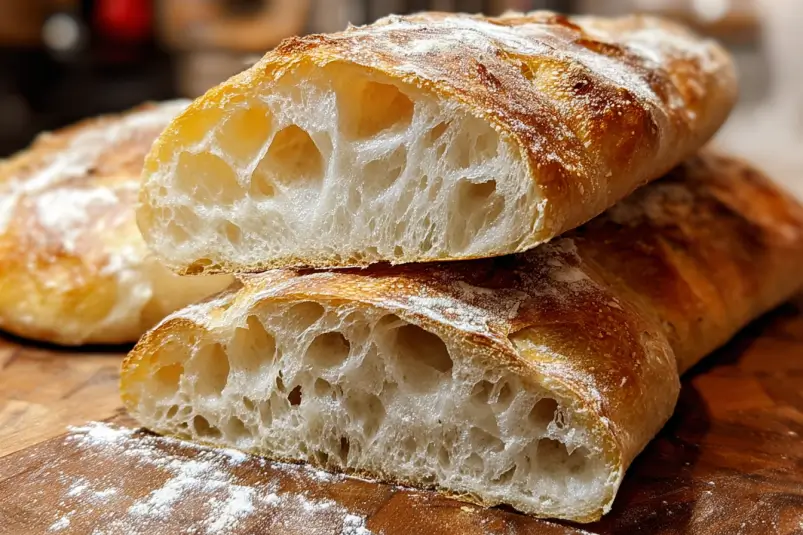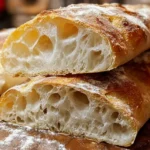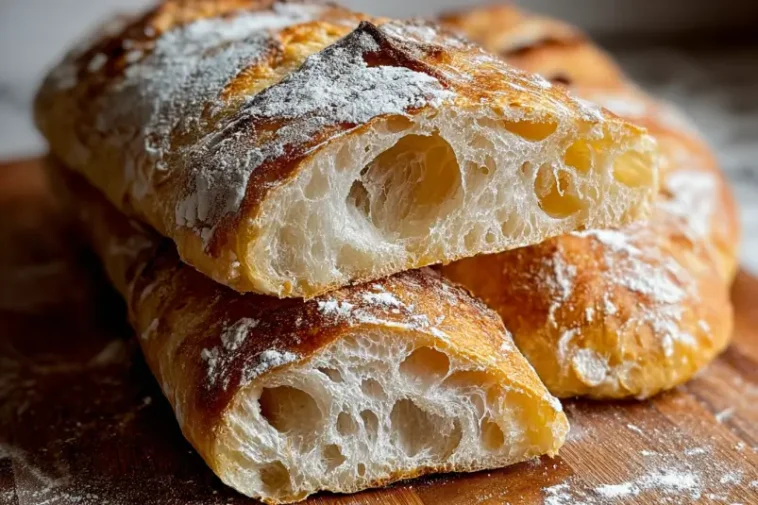Few things compare to the irresistible aroma of freshly baked bread filling your kitchen. Among the many types of artisan bread, ciabatta stands out for its rustic crust, chewy interior, and delicate flavor. Originating in Italy during the 1980s, ciabatta quickly became a favorite across the globe thanks to its unique open crumb texture and versatility. Whether you enjoy it as a sandwich base, a side for soups, or simply dipped in olive oil, ciabatta brings a touch of authenticity to any meal.
Making ciabatta at home may seem intimidating, but with the right approach and some patience, you can achieve bakery-quality results. This recipe will walk you through every step, from preparing the dough to baking the perfect loaf.
Ingredients
For two medium loaves:
For the sponge (biga, prepared the night before):
- 1 cup (240 ml) lukewarm water
- 1 cup (120 g) bread flour
- ¼ teaspoon instant yeast
For the dough:
- All of the prepared biga
- 2 ½ cups (300 g) bread flour
- 1 ½ teaspoons salt
- 1 teaspoon sugar
- ¾ teaspoon instant yeast
- ¾ cup (180 ml) lukewarm water
- 2 tablespoons olive oil

Instructions
Step 1: Prepare the Biga (the night before)
- In a medium bowl, mix water, flour, and yeast until a sticky dough forms.
- Cover tightly with plastic wrap and let it sit at room temperature for 12–16 hours. The sponge should double in size and develop bubbles, showing it is active.
Step 2: Make the Dough
- In a large mixing bowl, combine bread flour, salt, sugar, and yeast.
- Add the biga, lukewarm water, and olive oil.
- Mix until a sticky, shaggy dough forms. This dough should be wetter than typical bread dough.
Step 3: Knead and Develop Gluten
- Transfer dough to a floured surface. Use a bench scraper to handle it, since it will be sticky.
- Stretch and fold the dough rather than kneading traditionally. Flatten the dough slightly, fold it over itself, turn 90 degrees, and repeat.
- Continue for 8–10 minutes until the dough becomes smoother and elastic.
Step 4: First Rise
- Place the dough in a lightly oiled bowl. Cover with a damp towel or plastic wrap.
- Let it rise at room temperature for 1–2 hours, or until it doubles in size.
Step 5: Shape the Loaves
- Gently transfer dough to a well-floured surface. Avoid punching it down to keep the air bubbles.
- Divide into two equal portions.
- Shape each portion into a rough rectangle by folding the sides inward. Do not overwork; ciabatta should look rustic.
Step 6: Second Rise
- Place shaped loaves on parchment paper dusted with flour or semolina.
- Cover with a cloth and let them rise for 45–60 minutes. They should puff slightly but not spread too much.
Step 7: Bake
- Preheat oven to 450°F (230°C). Place a baking stone or sheet inside to heat. Add an empty pan on the lower rack for steam.
- Slide loaves onto the hot baking stone. Pour a cup of hot water into the lower pan and quickly close the oven door.
- Bake for 20–25 minutes until golden brown with a crisp crust. The internal temperature should reach 200°F (93°C).
- Cool loaves on a wire rack for at least 30 minutes before slicing.
Conservation and Storage
- Room temperature: Wrap cooled loaves in a clean cloth or paper bag and store for up to 2 days. Avoid airtight plastic bags, which soften the crust.
- Freezing: Slice the bread, wrap tightly in foil, and place in freezer bags. Freeze for up to 2 months. Reheat directly from frozen in a 350°F (175°C) oven for 10–12 minutes.
- Reviving stale bread: Lightly sprinkle with water, wrap in foil, and warm in the oven at 325°F (160°C) for 8–10 minutes.
Variations
- Whole wheat ciabatta: Replace up to 40% of bread flour with whole wheat flour for a nuttier taste.
- Herb ciabatta: Add 1 tablespoon each of chopped rosemary, thyme, or oregano into the dough.
- Olive ciabatta: Fold in ½ cup of chopped kalamata olives after the first rise.
- Cheese ciabatta: Sprinkle shredded Parmesan or Asiago cheese over the loaves before baking.
- Garlic ciabatta: Mix roasted garlic paste into the dough for extra flavor.
Serving Suggestions
- Slice and use for panini or deli-style sandwiches.
- Serve warm alongside soups, especially tomato or minestrone.
- Cut into strips and dip into olive oil with balsamic vinegar.
- Toast and top with bruschetta toppings like tomatoes and basil.
- Use as a rustic base for garlic bread or crostini appetizers.
Tips for Perfecting Ciabatta
- The dough should be wetter than most bread doughs. Resist the urge to add too much flour.
- Handle dough gently during shaping to preserve air pockets.
- Steam in the oven is crucial for a crispy crust.
- Use bread flour, not all-purpose flour, for stronger gluten development.
- Allow bread to cool completely before slicing to avoid gummy texture.
Conclusion
Fresh homemade ciabatta bread embodies the beauty of artisan baking: simple ingredients transformed through time and technique into a rustic, flavorful loaf. With its crisp crust and airy interior, ciabatta complements countless meals and adapts to creative variations. Whether served with hearty soups, as a sandwich base, or simply dipped in olive oil, this Italian classic proves that great bread elevates even the simplest dishes.
By mastering this recipe, you not only bring the warmth of fresh bread into your home but also gain the satisfaction of crafting a bakery-quality staple from scratch. With practice, your ciabatta will become a versatile favorite that never fails to impress.
Print
How to Make Fresh Homemade Ciabatta Bread
- Total Time: 45 minutes active + resting
- Yield: 2 medium loaves 1x
- Diet: Vegetarian
Description
Bake authentic Italian ciabatta bread at home with this step-by-step recipe. Crispy crust, airy crumb, and a rustic flavor perfect for sandwiches, soups, or dipping in olive oil.
Ingredients
For the Biga (prepared the night before):
1 cup (240 ml) lukewarm water
1 cup (120 g) bread flour
¼ teaspoon instant yeast
For the Dough:
All of the prepared biga
2 ½ cups (300 g) bread flour
1 ½ teaspoons salt
1 teaspoon sugar
¾ teaspoon instant yeast
¾ cup (180 ml) lukewarm water
2 tablespoons olive oil
Instructions
Prepare the Biga: Mix water, flour, and yeast in a bowl until sticky dough forms. Cover and let sit 12–16 hours until bubbly.
Mix Dough: In a large bowl, combine flour, salt, sugar, and yeast. Add biga, water, and olive oil. Mix into a shaggy dough.
Knead: On a floured surface, stretch and fold dough for 8–10 minutes until smooth and elastic.
First Rise: Place dough in an oiled bowl, cover, and let rise 1–2 hours until doubled.
Shape Loaves: Gently divide dough into two rectangles. Fold sides inward, keeping a rustic shape.
Second Rise: Place on floured parchment. Cover and rise 45–60 minutes.
Bake: Preheat oven to 450°F (230°C) with a stone or tray. Add an empty pan for steam. Transfer loaves to hot stone, pour water into pan for steam, and bake 20–25 minutes until golden.
Cool: Let bread cool on a rack for 30 minutes before slicing.
Notes
Dough should be sticky and wet—do not add too much flour.
Steam ensures a crisp crust.
Avoid punching down the dough to preserve air pockets.
Bread flour is essential for proper structure.
- Prep Time: 20 minutes (plus 12–16 hours resting)
- Cook Time: 25 minutes
- Category: Bread
- Method: Baking
- Cuisine: Italian
Nutrition
- Serving Size: 1 slice (50 g)
- Calories: 120
- Sugar: 1 g
- Sodium: 200 mg
- Fat: 2 g
- Saturated Fat: 0.3 g
- Unsaturated Fat: 1.5 g
- Trans Fat: 0 g
- Carbohydrates: 23 g
- Fiber: 1 g
- Protein: 4 g
- Cholesterol: 0 mg
Keywords: fresh homemade ciabatta bread, Italian ciabatta recipe, artisan bread






